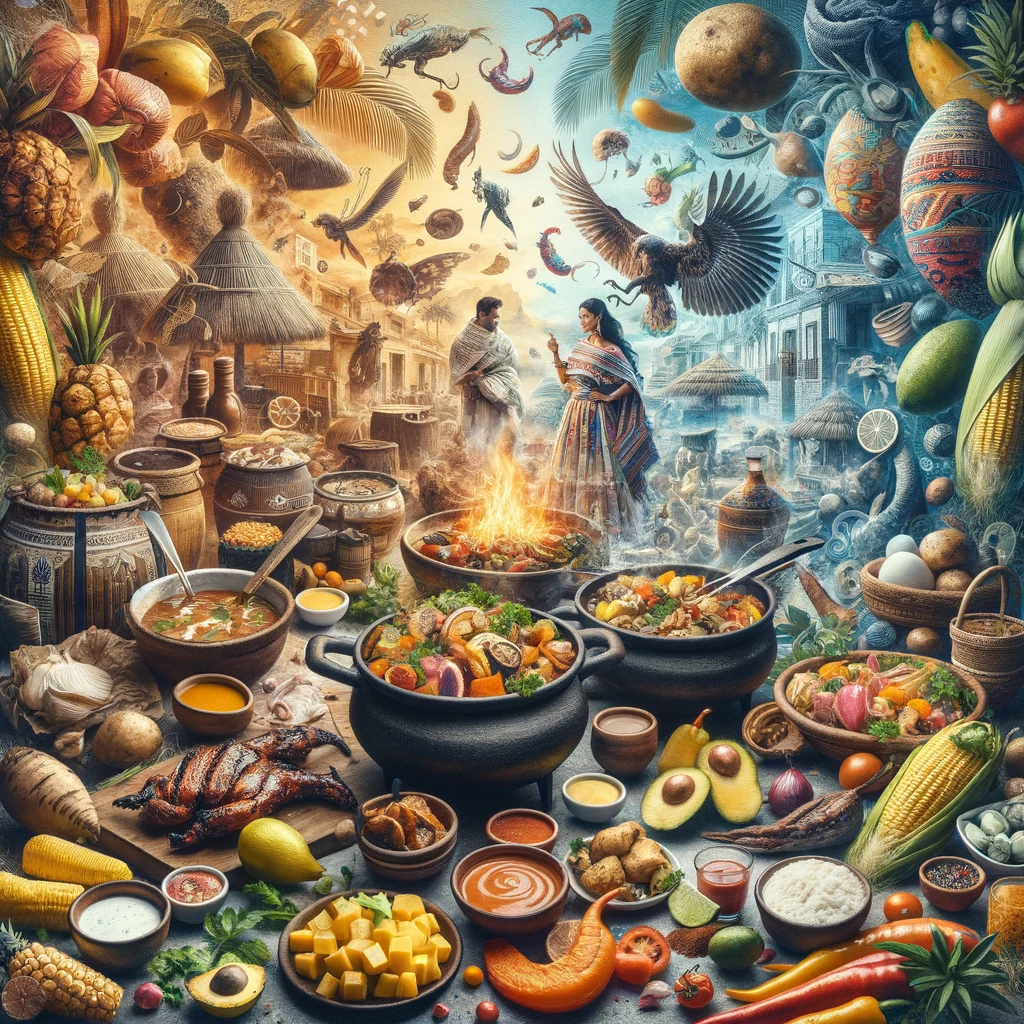Colonialism has significantly influenced the culinary landscapes of former colonies, shaping not only the ingredients and dishes but also the methods of preparation and sharing of food.
This text examines the complex history of colonialism and its impact on culinary traditions worldwide. It highlights the introduction of new ingredients and cooking techniques, as well as the fusion of various cuisines. The exploration includes how traditional foodways have evolved, adapted, and, in certain instances, been lost throughout this process.
The discussion also addresses the enduring legacy of colonialism on global food systems and the revival of traditional practices that continue to thrive in contemporary society.
The History of Colonialism and its Impact on Culinary Traditions and Food Anthropology
The history of colonialism has profoundly influenced culinary traditions worldwide, resulting in a complex tapestry of flavors and practices that emerge from cultural exchange, colonizers’ preferences, and the impact on cuisine, continuing to shape food identity today.
The spice trade and trade routes, which facilitated the introduction of indigenous ingredients into European cuisine, and the migration of recipes that combined local flavors with colonial influences, exemplify the significant impact of colonial powers on the food history and the globalization of food.
This historical context not only charts the evolution of gastronomy and culinary heritage but also underscores the lasting consequences of these interactions, particularly in relation to globalization, culinary migration, and the retention of cultural practices in former colonies.
1. The Spread of Ingredients and Cooking Techniques
The dissemination of ingredients, traditional recipes, and cooking techniques during the colonial era played a crucial role in the development of new culinary identities, resulting in the emergence of culinary fusion that integrated indigenous cuisine with foreign influences. As colonial powers established trade routes, they introduced a diverse array of ingredients and cooking methods that transcended geographical boundaries, facilitating the migration of recipes and the adaptation of local flavors, leading to cuisine hybridity.
For example, the introduction of spices from Asia significantly transformed traditional European dishes, with ingredients such as cinnamon and nutmeg becoming staples in numerous households. Similarly, the arrival of tomatoes and potatoes from the Americas revolutionized Mediterranean and Irish cuisines, respectively, fostering unique interpretations and techniques that preserved aspects of original methods while incorporating new flavors.
This interaction not only enriched culinary practices but also cultivated a growing appreciation for diverse food traditions, highlighting how the exchange of ingredients has become a fundamental aspect of contemporary gastronomy.
2. The Influence of European Cuisine on Local Dishes
The influence of European cuisine on local dishes represents a significant aspect of the culinary landscape in many former colonies, illustrating how colonial impact transformed indigenous culinary practices through the adaptation of recipes and the incorporation of new cooking methods. This blending of culinary traditions has resulted in dishes that reflect both local ingredients and European flavors, thereby creating a distinctive food heritage and showcasing the historical influence.
For instance, in various Caribbean regions, the integration of French culinary techniques led to the emergence of Creole cuisine, which is characterized by its robust flavors and the utilization of local spices in conjunction with European methods of preparation.
Similarly, in Southeast Asia, particularly in Vietnam, the introduction of French baguettes and pâtés has given rise to the popular bánh mì sandwich, symbolizing a cultural synthesis of flavors and traditions.
These examples underscore not only the adaptation of recipes but also the profound cultural significance of food as a medium for identity transformation and cultural preservation. They demonstrate how communities embrace and redefine their culinary narratives across generations.
4. The Creation of Fusion Cuisine
The emergence of fusion cuisine represents a dynamic interplay between culinary traditions, where multiculturalism fosters innovative flavor profiles that celebrate diverse cultural heritages. This phenomenon reflects the ongoing dialogue among various food practices and the evolution of gastronomy in response to globalization and cultural exchange.
Fusion cuisine not only highlights the creativity of chefs but also serves as a cultural narrative, interweaving stories of migration, adaptation, and heritage foods. Examples such as Korean tacos and sushi burritos exemplify how culinary adaptations can lead to the creation of playful yet thoughtfully conceived dishes that honor both traditional and contemporary influences.
As flavors merge and techniques intersect, the art of storytelling is essential in preserving ancestral recipes while allowing for experimentation, resulting in a culinary tapestry that embodies both familiarity and innovation. The outcome is a vibrant gastronomic landscape that invites exploration and appreciation of the rich variety of global ingredients and techniques.
The Effects of Colonialism on Traditional Foodways
The effects of colonialism on traditional foodways are profound and extend well beyond the culinary realm, resulting in the loss of valued recipes, traditional cooking methods, and indigenous food systems that have historically shaped cultural identity across generations.
As colonial powers imposed their influence, changes in food production and consumption not only transformed dietary practices but also redefined cultural significance, undermined community resilience, and affected social structures within former colonies.
1. Loss of Traditional Recipes and Cooking Methods
The loss of traditional recipes and cooking methods represents a significant consequence of colonialism, frequently resulting in cultural appropriation, colonial exploitation, and the erosion of heritage food practices that are essential to community identity. As indigenous culinary traditions became overshadowed, the transmission of food rituals and oral traditions encountered considerable challenges.
This cultural disruption is evident in various cuisines, particularly in the context of European colonization’s impact on African and Asian cooking practices, where local ingredients and methods were often supplanted by foreign techniques. For example, in certain regions of Africa, the introduction of Western agricultural products and land use changes not only altered local diets but also diminished the unique culinary identity associated with indigenous crops and traditional preparation methods.
Similarly, Asian cuisines, especially in Southeast Asia, underwent comparable transformations as colonial powers imposed their own gastronomic influences, frequently disregarding centuries-old recipes that encapsulated the essence of these cultures, leading to significant culinary diversity.
The implications of these changes extend beyond mere culinary preferences; they pose a challenge to the very foundation of community rituals centered around food, underscoring the urgent need to preserve these culinary heritages.
2. Shifts in Food Production and Consumption
Shifts in food production and consumption patterns during the colonial period had significant effects on local social structures and food systems, resulting in economic impacts and nutritional changes that continue to resonate today. These changes redirected agricultural practices towards the cultivation of cash crops intended for export, often undermining local food security and community resilience.
Consequently, traditional diets and cultural identities began to diminish, as communities became increasingly dependent on imported foods that were inconsistent with their historical practices and nutritional requirements. This shift not only reduced the diversity of local food options but also disrupted long-standing agricultural knowledge and practices, affecting social identity, social cohesion, and community pride.
The emphasis on export-oriented agriculture placed considerable strain on local economies, leading to disparities in wealth distribution and limiting access to nutritious food for many individuals. Ultimately, these transformations exemplify a critical legacy of colonialism, wherein the complexities of food production are inextricably linked to economic challenges and significant alterations in cultural landscapes.
3. Changes in Cultural Identity and Food Practices
Changes in cultural identity and food practices resulting from colonialism have significantly reshaped the food landscape, influencing the expression of ethnic diversity through culinary arts. The globalization of food systems has led to the hybridization of dishes that reflect both historical narratives and contemporary tastes, showcasing the culinary symbolism and cultural influences.
Culinary expressions serve as a platform for various communities to convey their unique heritage while simultaneously integrating new influences. As migration and technological advancements facilitate the movement of ingredients and recipes across borders, traditional dishes evolve, blending local flavors with global trends, resulting in culinary innovation and food globalization.
This evolution not only demonstrates the adaptability of culinary identity but also underscores the importance of community narratives in the preparation and consumption of food.
The emergence of social media platforms enables individuals to share their culinary creations, fostering a sense of belonging and promoting cross-cultural exchange. In this dynamic environment, food practices reflect ongoing dialogues surrounding identity, history, and belonging within a global context, influencing taste preferences and cultural dialogue.
The Legacy of Colonialism on Culinary Traditions Today
The legacy of colonialism on culinary traditions remains evident in contemporary society, as colonial food habits continue to shape modern dining experiences and inspire a resurgence of traditional food practices in various regions. This cultural exchange highlights the ongoing globalization of food and its impact on local cuisine.
This intricate interplay illustrates the complex relationship between colonial history and present-day global food systems, highlighting the influence of trade routes and the spice trade on food practices.
1. The Persistence of Colonial Food Habits
The persistence of colonial food habits in contemporary cuisine exemplifies the enduring influence of colonialism on culinary heritage and consumer behavior, often guiding preferences toward dishes that reflect colonial histories and the culinary adaptations made by former colonies.
This phenomenon prompts critical inquiries into food politics, cultural appropriation, and the impact on cuisine within the framework of global cuisine.
As culinary practices evolve, it is imperative to acknowledge how these historical influences shape modern tastes and dining experiences. Many popular dishes today, frequently characterized as fusion or exotic, can trace their origins to colonial exchanges that transformed local cuisines into hybrids, sometimes neglecting their historical roots and traditional recipes.
These trends not only affect the variety of food available but also mirror broader societal values and power dynamics in food production and consumption. The uncritical adoption of these food habits can lead to a disconnection from their cultural significance, highlighting the need for a more profound understanding of the relationship between food choices, agricultural practices, and the histories they encompass.
2. The Revival of Traditional Foodways
The revival of traditional foodways is emerging as a significant response to the legacy of colonialism, emphasizing sustainability and cultural preservation as communities seek to reclaim their culinary heritage. This movement underscores the importance of food sovereignty, indigenous food systems, and the role of indigenous ingredients in contemporary gastronomy.
By revitalizing these time-honored practices, communities aim to cultivate a deeper connection to their cultural roots and assert their identities in an increasingly dynamic world. These efforts not only celebrate distinctive culinary traditions but also highlight the necessity for ecological balance by promoting local farming practices and cultural legacy that respect and nurture the environment.
The incorporation of indigenous ingredients into daily meals serves as a poignant reminder of the land’s bounty, fostering a movement towards more mindful eating. As more individuals embrace this initiative, they contribute to a rich tapestry of flavors that not only satisfy the palate but also nourish cultural identity, promote sustainability, and celebrate culinary diversity.
3. The Impact on Global Food Systems
The impact of colonialism on global food systems is significant, shaping culinary globalization and influencing food security across various regions. The economic ramifications of these historical interactions continue to affect community resilience, social structures, and the sustainability of local food practices.
While certain culinary traditions have thrived, others have been marginalized, resulting in a complex array of food security challenges and social changes that numerous communities face today.
The emergence of monocultures and dependence on cash crops can be directly attributed to colonial agricultural policies, which often prioritized exportation over local consumption. This has led to a reduction in biodiversity, changes in nutritional practices, and an increased vulnerability to food shortages, particularly in developing countries.
However, there are also emerging opportunities stemming from heightened awareness and initiatives aimed at revitalizing indigenous food systems. These efforts enable communities to reclaim their culinary heritage, promote food justice, and address economic disparities.
Such dynamics underscore the ongoing struggle for food sovereignty within the context of the interwoven legacies of colonialism, culinary migration, and cultural dialogue.
Frequently Asked Questions
1. How did colonialism impact the culinary traditions of former colonies?
Colonialism had a significant impact on the culinary traditions of former colonies, as it introduced new ingredients, cooking techniques, and cultural influences that greatly influenced the local cuisine and food identity.
2. What are some examples of colonial influence on the culinary traditions of former colonies?
Examples of colonial influence on culinary traditions include the introduction of spices and herbs from Europe and Asia, the adoption of cooking techniques from colonizing countries, and the fusion of different cuisines, leading to unique regional flavors and cuisine hybridity.
3. Did colonialism have a positive or negative impact on the culinary traditions of former colonies?
The impact of colonialism on culinary traditions is often a complex and controversial topic. While it brought new flavors and techniques, it also led to the erasure of indigenous foods and cultural practices, leading to both positive and negative impacts and raising issues of cultural preservation.
4. How have former colonies adapted their culinary traditions in response to colonialism?
Former colonies have adapted their culinary traditions by incorporating new ingredients and techniques while also preserving and reclaiming their indigenous foods and cooking methods. This has resulted in unique and diverse fusion cuisines and culinary storytelling that reflect historical narratives of migration and cultural exchange.
5. How has the legacy of colonialism affected the perception of former colonies’ culinary traditions?
The legacy of colonialism has often resulted in the devaluation and stigmatization of former colonies’ culinary traditions, as they were seen as inferior to Western cultures. However, there has been a recent shift towards celebrating and appreciating these traditions as part of a broader move towards recognizing the significance of cultural identity and culinary diversity.
6. What can we learn from the impact of colonialism on the culinary traditions of former colonies?
The impact of colonialism on culinary traditions serves as a reminder of the power dynamics and cultural appropriation that have shaped our global food culture. It also highlights the resilience and adaptability of these traditions, the evolution of recipes, and the importance of preserving and honoring diverse cuisines, sustaining traditional ingredients, and fostering cross-cultural interactions.

My name is Bruno, I have been a writer for 5 years and I work with website creation. My goal is to provide true information to readers. In fact, on this site I write about cultures and traditions, which I have been passionate about since childhood.




